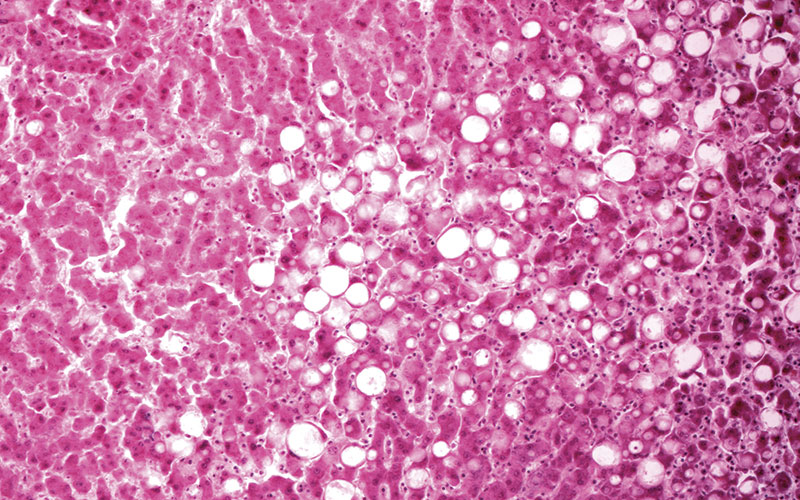Editor Andrew Blann outlines the content of the Spring issue of the journal.

The liver
This issue kicks off on pages 53-58 with a cohort study from China of 1527 patients with non-alcoholic fatty liver disease (NAFLD) and the likelihood of urolithiasis (kidney/bladder stones). Their primary result is that NAFLD is linked to obesity and serum uric acid (perhaps unsurprisingly), but also to the ratio between asparate transaminase to platelet count (APRI), pointing to the use of these markers in diagnosis. Elalfy et al from Egypt also studied NAFLD (pages 101-103), reporting high titres of anti-smooth muscle cell antibodies in over half of their 124 patients that were linked to high serum gamma-globulins, a histological activity index, liver fibrosis, NASH score and steatosis.
Focus on the liver continues on pages 64-69 with the study of Arafa et al from Saudi Arabia of 70 patients with cirrhosis, 70 with hepatocellular cancer (all of whom had hepatitis C infection) and 70 controls. Their main finding is that certain SNPs in a DNA-repairing gene called XRCC1 are linked to the presence of the cancer. We may speculate that this association is causative, a hypothesis that can only be answered with long-term follow-up studies, probably lasting decades. A further paper of interest to hepatologists by Al-Radaideh and colleagues from Jordan (pages 70-76), who looked at the percentage of hepatic fat, as defined by magnetic resonance imaging, of a cohort of 156 healthy subjects. They found that hepatic fat levels were linked positively to waist and hip circumference, BMI, leptin, resistin and trigylcerides, and inversely with adiponectin. This study provides the essential physiological data required by pathological studies.
Andrology
Two short papers are of interest to andrologists. There are numerous risk factors for male infertility, such as pituitary pathology, and others include testicular trauma and genetic abnormalities. Eslaminejad et al, from Iran, report on pages 98-100 of a link between an SNP in the gene for bone morphometic protein 4 and low serum levels of this molecule, in 100 infertile men compared to 126 fertile men, suggesting that this gene and/or its product may be useful in diagnosis. Shabani and colleagues, also from Iran, in a study of similar design on pages 86-88 of 185 infertile men and 200 fertile men, show that an SNP in glial cell-derived neurotrophic factor, a molecule important in spermatogenesis, is linked to azoospermia and asthenospermia, but not to oligozoospermia.
Immunocytochemistry and molecular pathology
Although molecular genetics continues its inexorable progress in medical laboratory science, traditional techniques still have their place. BRAF mutations are present in numerous cancers, and can be detected in tissues with an appropriate DNA probe, a method which is expensive and slow. Orchard and colleagues show in pages 77-82, in a study of malignant melanoma, that immunocytochemistry has 100% specificity for the cancer, and is both quicker and cheaper. The former is important because a rapid result is highly desirable so that, if needed, treatment of this disease can proceed as soon as possible. However, two other papers demonstrate the value of molecular genetics. Aminian et al, from Iran, show in pages 83-85 that a functional genetic variant in a long non-coding RNA (lncRNA) confers a risk of gastric cancer, a malignancy most often linked to Helicobacter pylori. The mechanism is that the lncRNA acts on second messenger and tumour suppressor p27, that itself part-regulates the cell cycle. Thus this particular lncRNA may part-regulate p27, the consequences of which could include inappropriate promotion of a potentially malignant cell. There are several genes with links to breast cancer, the principles being BRCA1 and BRCA2, although there are others known and yet to be discovered. Maroufi and colleagues report, on pages 89-91, no differences in SNPs in genes for IL-27 and IL-33 in 140 women with breast cancer compared to 140 healthy women, thus excluding these SNPs from further studies.
Microbiology
Microbiologists will find interest in three papers. For virologists, toll-like receptors (TLRs) have roles in the innate immune system. Vidyant et al, from India and the USA, show, on pages 59-63, differences in an SNP in TLR4 in 160 patients positive for HIV and 270 negative for HIV. However, this does not suggest that this SNP protects against HIV as the two groups may not have accrued the same risk factors for acqusition of the virus. Bacteriologists will find interest in two papers from Iran. Mahdavi and Isazedeh show, on pages 92-94, that Lactobacillus casei suppresses the expression of virulence-promoting gene hfq. This in vitro data supports the hypothesis of so-called “friendly” bacteria. Bakhti and colleagues report on pages 95-97 that cagG, but not cagH, cagL or orf17 in H. pylori is more prevalent in duodenal ulceration than in gastric ulceration.
CPD
In common with previous articles, any of the above may be the subject of Journal-based learning.
